1. Introduction
Why BTC-LST?
With the birth of Babylon, it adds additional yield to BTC by providing a security service called timestamping. This re-staking service protects the protocol built on Babylon by increasing the cost of attack and makes BTC staking possible through a time lock mechanism.
While there are no actual staking rewards in the first phase, but points are given, the potential for BTC yields has inspired a wave of BTC Liquid Re-staking Tokens (BTC-LST), such as Lombard, babypie, FBTC, and SolvBTC.
Compared to wrapped BTC, which acts as a cross-chain representation of native BTC, BTC LST leverages the Babylon protocol to introduce a cross-chain BTC representation with yield.
As of this writing, the BTC LST market has reached $1.07 billion (excluding the 9BWBTC assets on Ethereum). The market is mainly dominated by SolvBTC and Lombard, and the growth momentum shows no signs of slowing down.
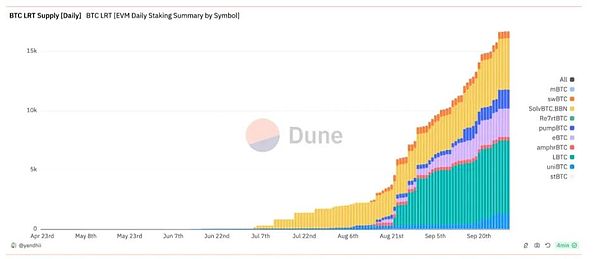
Source: @yandhii , dune dashboard
On the other hand, many DeFi or re-staking platforms on Ethereum (such as Symbiotic, Karak, etc.) saw the opportunities brought by the influx of BTC assets with yields and began to integrate these assets into their protocols to guide the total locked value (TVL) and transaction volume.
This phenomenon is extremely bullish as the inflow of assets can strengthen Ethereum’s position as the liquidity center of the DeFi field and continue to create a flow of economic activities.
As BTC becomes more accepted by institutions and the public, as can be observed from recent news such as BTC ETF, cbBTC, not to mention BTC’s dominance (about 58%), it is expected that BTC’s adoption will continue to grow until new innovations emerge. Therefore, it is necessary to have a clear understanding of the current BTC LST-fi landscape.
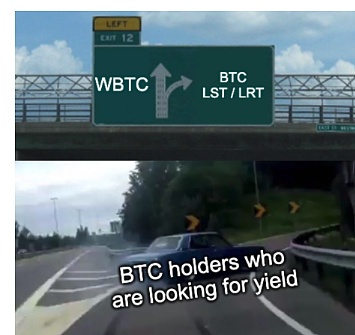
Source: Henry
This study aims to comprehensively sort out the existing BTC-LRT, BTC wrappers, and DeFi protocols that follow the emerging trend of BTC wave on Ethereum, so that it can be more easily navigated in the future.

2. BTC-LST Ecology
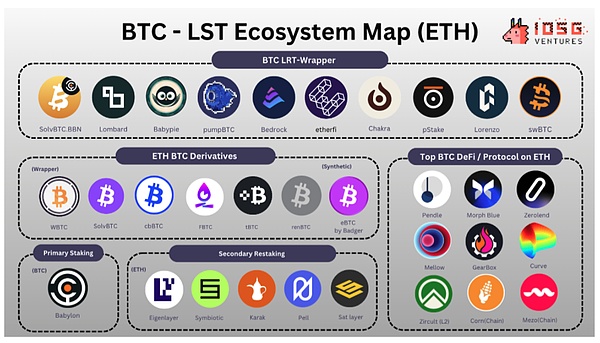
Source: IOSG
Bitcoin LST Wrapper is a "new member" of this cycle, designed to unlock the liquidity of staked tokens in the BTC re-staking protocol Babylon.
BTC liquidity wrappers usually come in three forms:
One is a one-way cross-chain wrapper, backed by BTC staked by Babylon in the BTC mainnet at a 1:1 ratio. "Yield-generating tokens" minted on ETH serve as receipts for staked BTC.
Examples: LBTC, pumpBTC, babypie's mBTC, etc.
Wrappers that use LBTC or regular BTC (such as WBTC) as collateral and re-pledge the assets to re-pledge platforms such as Symbiotic and Karak. On Ethereum, use LBTC or regular BTC (WBTC) as collateral, and then re-pledge these assets to re-pledge platforms such as Symbiotic and Karak.
Example: Etherfi's eBTC, Swell's swBTC
"Reverse mode", using WBTC as collateral on ETH and passing proof of stake to Bitgo through an oracle, allowing BTC unlocked from Bitgo to be staked into Babylon to generate yield. "Reverse mode" users can use WBTC as collateral to unlock native BTC on the mainnet and stake it on the Babylon platform. They pass the proof of stake to Bitgo through an oracle, which unlocks the BTC and uses it for staking on Babylon to earn yield.
Example: Bedrock
While the first two types focus on bridging or unlocking more BTC assets from the BTC mainnet to the ETH ecosystem, the latter type extracts WBTC assets from ETH and "reversely" stakes the assets to the Babylon protocol. In terms of architecture, one thing these wrappers have in common is that BTC is stored in a custodian (such as Cobo or Copper) on the BTC mainnet to protect its assets, which is the cheapest and most convenient way. To give a clearer picture of the entire BTC LST/LRT landscape, here is a summary of how some BTC LST/LRTs work:
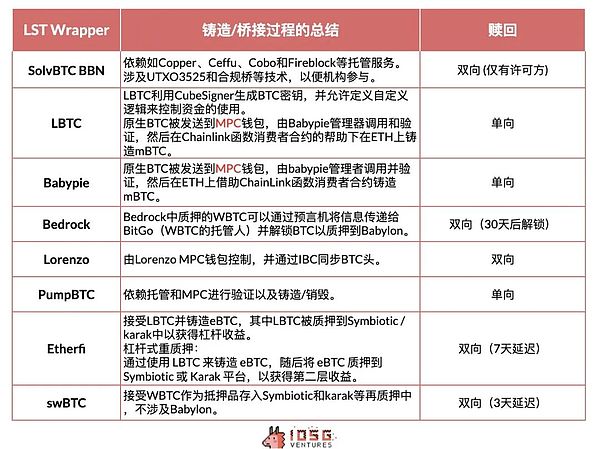
Source: Henry
BTC LST Market Size
As of this writing, LBTC dominates with a 37% market share, followed by solvBTC's 26% and pumpBTC's 9.5%. 79.6% of BTC LST is on the Ethereum mainnet, while the remaining 21.4% is scattered across BNB chain, Arbitrum, Avalanche and other networks.
The two major players in the BTC LST market have taken different approaches. Lombard focuses on Ethereum, while SolvBTC takes a multi-chain approach, opening up various networks including BNB, ARB, etc.
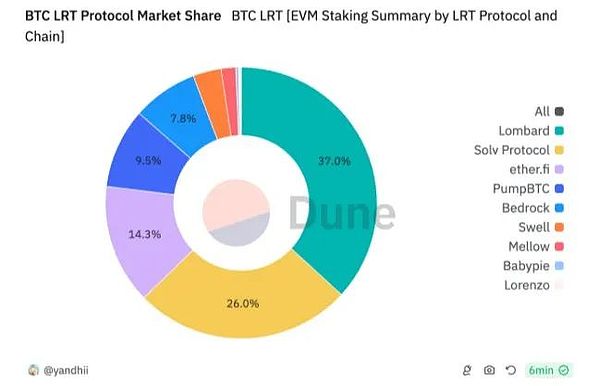
Source: @yandhii , dune dashboard
2.1 ETH BTC Derivatives (Wrappers and Synthetics)
ETH BTC derivatives are wrapped BTC that are bridged from the BTC mainnet to the ETH network, usually through a custodian. These wrappers are not competitors to BTC LST, but rather serve as a key factor in driving LST growth.
Unlike BTC LST, these derivatives are not staked into the Babylon protocol and do not inherently generate yield. Instead, they are ordinary representations of BTC on the ETH blockchain. Despite not being a yield-generating asset per se, ETH BTC derivatives have become a key component of today’s ETH DeFi landscape.
Most DeFi and re-hypothecation platforms accept WBTC because:
As of this writing, Bitgo’s WBTC has bridged over $9 billion in assets from BTC to ETH since 2018. Of this, 21.5% (about $1.9 billion) has been deposited in Aave for lending, accounting for about 20% of Aave’s total assets on ETH.
Most DeFi and re-staking platforms accept WBTC because:
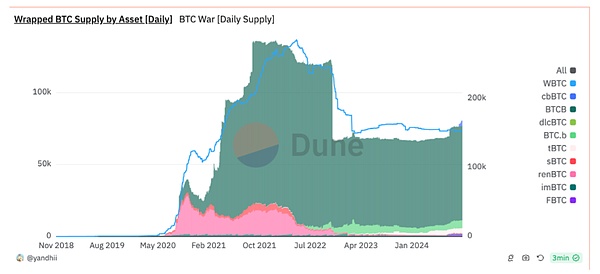
Source: @yandhii , dune dashboard
On the other hand, the new generation of Wrappers (E.g., FBTC), have also accumulated more than $152 million on ETH, with a monthly growth rate of 38% according to DeFillama data. Another wrapper, SolvBTC, has also attracted more than $800 million in TVL on BSC and BTC L2 such as Merlin.
These figures not only demonstrate the importance of BTC assets in the ETH ecosystem, but also highlight the huge potential for ETH DeFi to take advantage of this opportunity.
As mentioned above, the main problem with WBTC is trust in the custodian.
Recently, there have been growing concerns about WBTC's relationship with Justin Sun, leading Sky (formerly Maker) to consider removing WBTC variants from their vaults. BA Lab outlined the main concerns, mainly around the argument that Justin Sun may have significant influence or control over the joint venture that manages WBTC. However, Justin Sun himself claims that he does not have any control over WBTC or its holdings. This transfer should also be considered a risk for WBTC.
2.2 BTC Re-staking
BTC re-staking refers to BTC-related assets on ETH (in the form of wrapped BTC or BTC LST) that have been re-staking to generate yield.
The following table shows each asset accepted on the staking platform and their respective TVL:
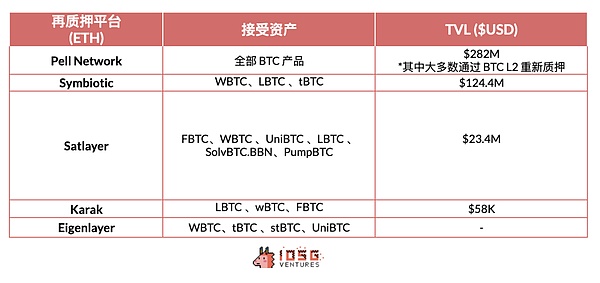
Source: Henry
In total, about $150 million of BTC is being re-staking on ETH, most of which belongs to Symbiotic and some is deposited in SatLayer. Symbiotic alone holds $124 million worth of BTC products, including WBTC and tBTC, and $10 million worth of staked BTC LST. Karak, on the other hand, has only about $100,000 in BTC assets. Together, these BTC assets contribute 7% to Symbiotic's TVL.
On the other hand, Pell Network has successfully attracted a large amount of BTC LST to be re-pledged through various BTC second-layer solutions such as Bitlayer and B2network. These assets will be used to provide shared security services and generate returns, similar to the model adopted by Babylon Finance and Eigenlayer.
While BTC LST has received first-layer returns from Babylon, some protocols such as EtherFi are leveraging BTC-LST to generate second-layer returns by re-staking LST to other re-staking platforms such as Eigenlayer, Symbiotic, and Karak.
Although this strategy allows stakers to enjoy leveraged returns and maximize the capital efficiency of a single asset, they also face the same risk as ETH LST, that is, being slashed by multiple platforms at the same time) Babylon, Symbiotic slashed).
Anti-Slashing policies can prevent a certain degree of slashing on ETH, but further information about Babylon is unclear.
2.2.1 BTC-DeFi
There is no doubt that DeFi has been one of the most important areas driving blockchain economic activities. With the growth of the $9.5 billion BTC asset market on ETH, DeFi on ETH can benefit from the stability, institutional recognition, and potential returns provided by BTC.
In general, in addition to exchange, BTC / BTC-LST related DeFi can be divided into two major areas:
Money Market & Interest Rate Swap: Morph blue, Aave, Pendle, Zerolend, Curve
BTC Staking / Points Strategy: Corn, Meso, Gearbox, Mellow

Source: IOSG
2.2.2 Money Market
BTC, as the most "safe" asset, is the most secure asset in ETH Commonly used as collateral in the DeFi landscape. Aave is the oldest and most prestigious money market, with over $2 billion in WBTC deposits but only $218 million in borrowings, and a relatively low utilization rate (7.69%) relative to stablecoins (86.7%) or WETH (85%).

Source: @KARTOD, Dune dashboard
On the other hand, Morpho Blue, despite having a smaller deposit base (20% of Aave's), has achieved a higher utilization rate. The most popular market on Morpho Blue is WBTC/USDC, which has a utilization rate of up to 90%.

Source: WBTC/USDC Vault, Morphblue
So far, Aave and Morph only accept WBTC. In order to stand out in the competitive lending market, zeroland is the first market dedicated to BTC LST tokens and supports PT-eBTC. To date, they have $17 million worth of eBTC supply, about $3.28 million has been lent, and the utilization rate is 20%.
In addition, Curve is not only a safe haven for stablecoin exchange, but also a popular destination for BTC-related assets to deposit assets. On Curve, BTC suppliers can do two things: First, they can provide liquidity to the three pools. Secondly, they can borrow crvUSD using tBTC and WBTC as collateral.
As of the time of writing, about $50 million worth of BTC assets have been deposited for borrowing crvUSD. On the other hand, among the available pools, the tBTC - WBTC pool stands out with $25 million in assets and $2.24 million in daily trading volume. Unfortunately, despite the active BTC-related assets on Curve, $CRV incentives have not yet been offered to attract users.
2.2.3 Interest Rate Swap (IRS) 换
In addition to the money market, the interest rate swap (IRS) product provided by Pendle is also one of the most popular places for BTC LST DeFi.
Pendle leverages the future earnings of BTC LST and speculation on points to create multiple dedicated markets: SolvBTC.BBN, PT/YT for LBTC and eBTC, among others. Together, these markets attracted over $136 million in funding, up 150% month-over-month, driven by points and incentive farming.
The new round of voting incentives also marks a growing interest in BTC LRT. For example, SolvVBTC in Corn was selected to attract the most Emission from Pendle. As a result, it is expected that the supply of BTC LRT assets will continue to grow in the near future, taking into account emission incentives.
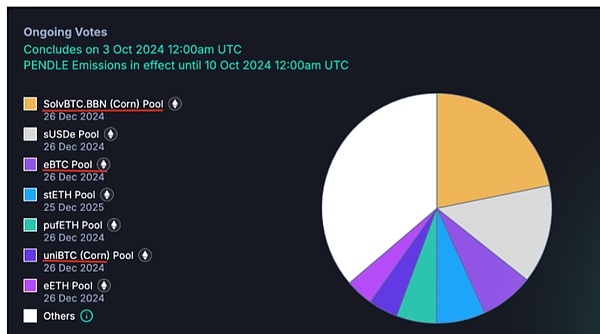
Source: Pendle Dashboard
2.2.4 TVL Bootstrapping Vaults / Points Strategies
While Money Market and IRS products generate additional yield for BTC assets based on the demand and supply of BTC on the ETH mainnet, TVL Bootstrapping Vaults prioritize using BTC to increase the TVL of their respective chains to promote the growth of the ecosystem. In addition, some vaults offer leveraged points farm strategies by recycling or borrowing BTC to maximize returns with the same capital.
Gearbox offers up to 27x lombard points by leveraging WBTC (up to 7x). However, this service is not popular because the supply in gearbox is very limited (only about $3 million).
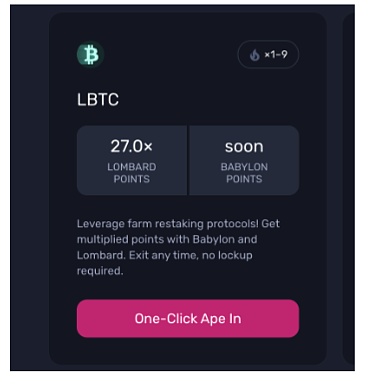
Source: gearbox.fi
In addition to the points strategy, some second-layer networks, such as Thesis's Mezo and Binance Labs-backed Corn, are leveraging the value of BTC by allowing nodes to "stake" bridged BTC LSTs as collateral. In return, nodes earn $BTC fees by participating in the verification process, which is a good attempt to leverage BTC and guide the TVL of these networks to promote future ecosystem growth. So far, Mezo has attracted $121 million in BTC-related assets and $20 million in Corn.
So far, it is clear that most DeFi activities related to BTC LSTs are primarily incentive-driven. While BTC adoption is growing, in the long run, the actual demand for generating BTC LSTs will be highly dependent on Babylon's yield performance, which may make BTC LSTs a more attractive asset than ETH.
2.2.5 Liquidity Issues
Despite having $300 million TVL, the deepest pool has only about $10 million in liquidity in the Uni v3 pool (according to nansen). Swapping $345,000 of ETH for LBTC would result in a 1.06% slippage, which is 4 times that of WBTC (about 0.4%). This difference reflects a key problem that BTC LSTs must overcome: liquidity issues when exiting large-scale from LBTC positions.
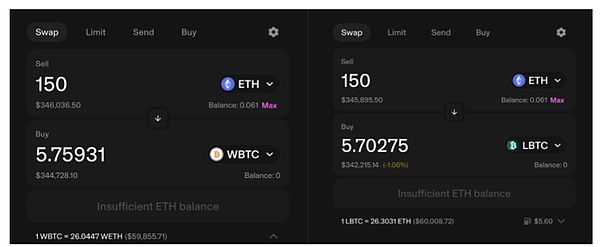
Source: Uniswap

3. Summary
Bridging BTC can mainly take two forms: ordinary BTC, such as Wrapped BTC (WBTC), and BTC that is re-pledged in Babylon, called BTC-LST.
The BTC LST/LRT-Fi landscape is in its early stages but shows healthy signs of bridging more TVL from BTC to the ETH DeFi ecosystem.
Due to BTC’s growing recognition and market dominance in the current cycle, BTC adoption is expected to increase. The opportunity to generate yield for BTC is also creating a market on ETH for speculative and trading activities.
WBTC remains one of the most widely adopted forms of BTC on ETH. However, due to the recent challenges associated with Justin Sun, tBTC or LBTC is expected to gain more adoption.
It is increasingly common to see BTC re-collateralized tokens being re-collateralized in Symbiotic or Karak for leveraged farming. While this may generate higher yields, users must bear the risk of facing multiple slashing events.
Money markets and interest rate swaps are the most in-demand BTC DeFi activities on ETH, and attempts from Layer 2 to use BTC as a fee in the validation process are also interesting.
Currently, most BTC-related DeFi activities on ETH are mainly incentivized by points or rewards. In order to generate actual demand, BTC LSTs need to create value (possibly in the form of earnings) that is greater than ETH LSTs.
Custody risk, haircut risk, and liquidity risk are the main concerns in the BTC LST landscape.
 Alex
Alex




















